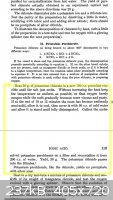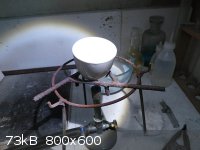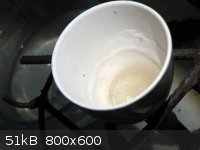metalresearcher
National Hazard
   
Posts: 731
Registered: 7-9-2010
Member Is Offline
Mood: Reactive
|
|
KClO3 heated to make KClO4
In an old chemistry textbook "Laboratory methods of Inorganic Chemistry by Biltz" (1928) I found this (1st picture) so I tried it out.
Not 50g but 10g of KClO3 heated in a porcelain crucible just to melt (I checked the temperature with an infrared thermometer and kept it around
400ºC) and let it cool down.
No bubbles of oxygen appeared so there was virtually no decomposition to KCl.
Tomorrow I'll add 10ml of cold water to extract KCl and see whether really KClO4 forms.
  
[Edited on 2013-8-20 by metalresearcher]
|
|
|
Varmint
Hazard to Others
  
Posts: 264
Registered: 30-5-2013
Location: Near Atlanta, GA
Member Is Offline
Mood: No Mood
|
|
Do a search for: AD003174
It is a now unclassified US Govt document on the process and the real-world findings.
DAS
|
|
|
AJKOER
Radically Dubious
    
Posts: 3026
Registered: 7-5-2011
Member Is Offline
Mood: No Mood
|
|
Here is a related (untried) path based on Chloric acid HClO3. Per Wikipedia (http://en.wikipedia.org/wiki/Chloric_acid ), to quote:
"It [Chloric acid] is stable in cold aqueous solution up to a concentration of approximately 30%, and solution of up to 40% can be prepared by careful
evaporation under reduced pressure. Above these concentrations, and on warming, chloric acid solutions decompose to give a variety of products, for
example:
8HClO3 → 4HClO4 + 2H2O + 2Cl2 + 3 O2
3HClO3 → HClO4 + H2O + 2 ClO2
The decomposition is controlled by kinetic factors: indeed, chloric acid is never thermodynamically stable with respect to
disproportionation...Chloric acid is a dangerously powerful oxidizing agent and will cause most organics and flammables to deflagrate on contact. "
Now, a problem that has been experienced using Oxalic acid to prepare acids (see thread http://www.sciencemadness.org/talk/viewthread.php?tid=18963&... ), is that it does create, at times, a highly concentrated version of the acid
that is capable of further oxidizing excess H2C2O4 itself to gases (dangerously so at times). However, per the above comments per Wikipedia,
targeting a concentration of HClO3 of 40% should be doable. On warming, Perchloric acid is formed and adding K2CO3 forms KClO4, H2O and CO2.
----------------------------------------------------------------------------------------------------------------------
Another path (also untried) is via Chlorine perchlorate which is prepared by the photolysis of ClO2 at room temperature and reacting the Chlorine
perchlorate with KCl to form KClO4 (see discussion at Wikipedia under Chlorine perchlorate).
[Edited on 22-8-2013 by AJKOER]
|
|
|
kristofvagyok
National Hazard
   
Posts: 659
Registered: 6-4-2012
Location: Europe
Member Is Offline
Mood: No Mood
|
|
It works, it is a good old recipe, there is just only a little problem with it: if traces of oxidizable organics is somehow left in the crucible or in
the KClO3, than it could easily explode. Not joke.
I have a blog where I post my pictures from my work: http://labphoto.tumblr.com/
-Pictures from chemistry, check it out(:
"You can’t become a chemist and expect to live forever." |
|
|
Pyro
International Hazard
    
Posts: 1305
Registered: 6-4-2012
Location: Gent, Belgium
Member Is Offline
Mood: No Mood
|
|
Ive had something similar to that.
I had ground S and a few days later I ground KClO3 in it and could hear little pops
all above information is intellectual property of Pyro.  |
|
|
Pulverulescent
National Hazard
   
Posts: 793
Registered: 31-1-2008
Member Is Offline
Mood: Torn between two monikers ─ "hissingnoise" and the present incarnation!
|
|
Quote: Originally posted by Pyro  | Ive had something similar to that.
I had ground S and a few days later I ground KClO3 in it and could hear little pops |
I fail to see the similarity, can you enlighten us?
"I know not with what weapons World War III will be fought, but World War IV will be fought with sticks and stones"
A Einstein
|
|
|
AndersHoveland
Hazard to Other Members, due to repeated speculation and posting of untested highly dangerous procedures!
    
Posts: 1986
Registered: 2-3-2011
Member Is Offline
Mood: No Mood
|
|
I also want to point out here that it is important that the chlorate being heated is free from transition metal impurities. If the chlorate contains
any manganese salts, for example, it will have a strong catalytic effect and heating will result in decomposition of the chlorate to oxygen before any
perchlorate can form.
And to get rid of the remaining chlorate, just add hydrochloric acid. Hydrochloric acid will reduce the chlorate but not react with the perchlorate.
The perchlorate can then be removed by fractional crystallization, either as potassium perchlorate or ammonium perchlorate, since these are much less
soluble than chlorides. In contrast to the other salts formed by ammonia, ammonium perchlorate is one of the least soluble ammonia salts, almost
surprisingly so.
Another variation of this reaction...
Fowler and Grant found that on heating chlorate with silver oxide that the chlorate was completely converted to perchlorate without loss of oxygen,
metallic silver also forming.
J. Chem. Soc. 57, 272 (year 1890)
[Edited on 23-8-2013 by AndersHoveland]
|
|
|
Pulverulescent
National Hazard
   
Posts: 793
Registered: 31-1-2008
Member Is Offline
Mood: Torn between two monikers ─ "hissingnoise" and the present incarnation!
|
|
| Quote: | | Fowler and Grant found that on heating chlorate with silver oxide that the chlorate was completely converted to perchlorate without loss of oxygen,
metallic silver also forming. |
Interesting! I found the reaction mentioned here!
| Quote: | | Oxide of Silver, " Although the mixture of silver oxide and chlorate was heated for considerably over an hour at a temperature far above that at which
silver oxide decomposes (270" " 280"), no evolution of gas took place. On treating the contents of the bulb with hot water and filtering, pure silver
was left behind, and the filtrate contained large quantities of potassium perchlorate. |
"I know not with what weapons World War III will be fought, but World War IV will be fought with sticks and stones"
A Einstein
|
|
|
Varmint
Hazard to Others
  
Posts: 264
Registered: 30-5-2013
Location: Near Atlanta, GA
Member Is Offline
Mood: No Mood
|
|
Unfortunately, the text Posted by Pulverulescent and the assertion made by AndersHoveland aren't in complete agreement.
"large quantities" and "completely converted" leaves quite a bit of room between the two. This isn't a jab at either poster of course, I'm just
pointing out the deficiencies of a record that consited of generalities, not specific weights and measures.
If they had taken time to state the mols in/out, and justified directly (100% perchlorate + metallic Ag) there would be no wiggle room. As it stands,
the match doesn't quite play out.
AD003174 suffers similar deficiencies, they clearly say "the stated reactions are oversimplified". Lets take a look at the section of the document
where they mention:
4 NaClO<sub>3</sub> + heat = 3 NaClO<sub>4</sub> + NaCl.
The go on to say 2 NaCl0<sub>3</sub> + (they meant =, so much for official document proofreading) 2 NaCl + 3 O<sub>2</sub>.
Seems to me there is a lot of missing data here, and while the disclaimer "The exact mechanism of the conversion is unknown" is somewhat standard, it
seems to be a pretty hefty understatement!
Ergo, even official government studies and evidenciary statements by researchers leave quite a bit to be desired when trying to nail things like this
down.
The upshot is, these two sources represent unsetlled science, neither one of the offers enough in the way of hard data to guarantee repeatability by a
3rd party. This means we (those interested in the topic) can take the time to run some clean processes, and in doing so, settle the Chlorate + heat =
Perchlorate issue, once and for all.
DAS
|
|
|
Pyro
International Hazard
    
Posts: 1305
Registered: 6-4-2012
Location: Gent, Belgium
Member Is Offline
Mood: No Mood
|
|
even though you think something is clean, it isn't and can be very dangerous in some situations
all above information is intellectual property of Pyro.  |
|
|
Pulverulescent
National Hazard
   
Posts: 793
Registered: 31-1-2008
Member Is Offline
Mood: Torn between two monikers ─ "hissingnoise" and the present incarnation!
|
|
| Quote: | | "large quantities" and "completely converted" leaves quite a bit of room between the two. This isn't a jab at either poster of course, I'm just
pointing out the deficiencies of a record that consited[sic] of generalities, not specific weights and measures. |
Thermal oxidation of chlorate isn't normally driven to completion either so incomplete conversion isn't a problem ─ the time required for
completion of conversion is . . .
"I know not with what weapons World War III will be fought, but World War IV will be fought with sticks and stones"
A Einstein
|
|
|
Varmint
Hazard to Others
  
Posts: 264
Registered: 30-5-2013
Location: Near Atlanta, GA
Member Is Offline
Mood: No Mood
|
|
Pulverulescent:
Interesting you took the time to argue for arguement's sake. If you or the other poster had mentioned speed as the focal point, then certainly your
reply would have merit.
Instead, you sought to find a way to reply to make it look as though I wasn't paying attention.
Hint: Paying attention was the genesis of my original post.
Thanks,
DAS
|
|
|
Pulverulescent
National Hazard
   
Posts: 793
Registered: 31-1-2008
Member Is Offline
Mood: Torn between two monikers ─ "hissingnoise" and the present incarnation!
|
|
| Quote: | | Instead, you sought to find a way to reply to make it look as though I wasn't paying attention. |
What's this? I give info and you get paranoid?
"I know not with what weapons World War III will be fought, but World War IV will be fought with sticks and stones"
A Einstein
|
|
|